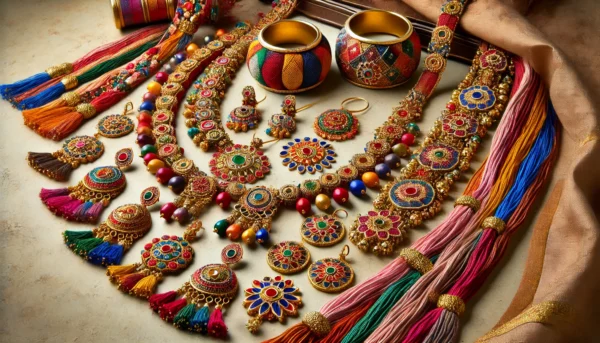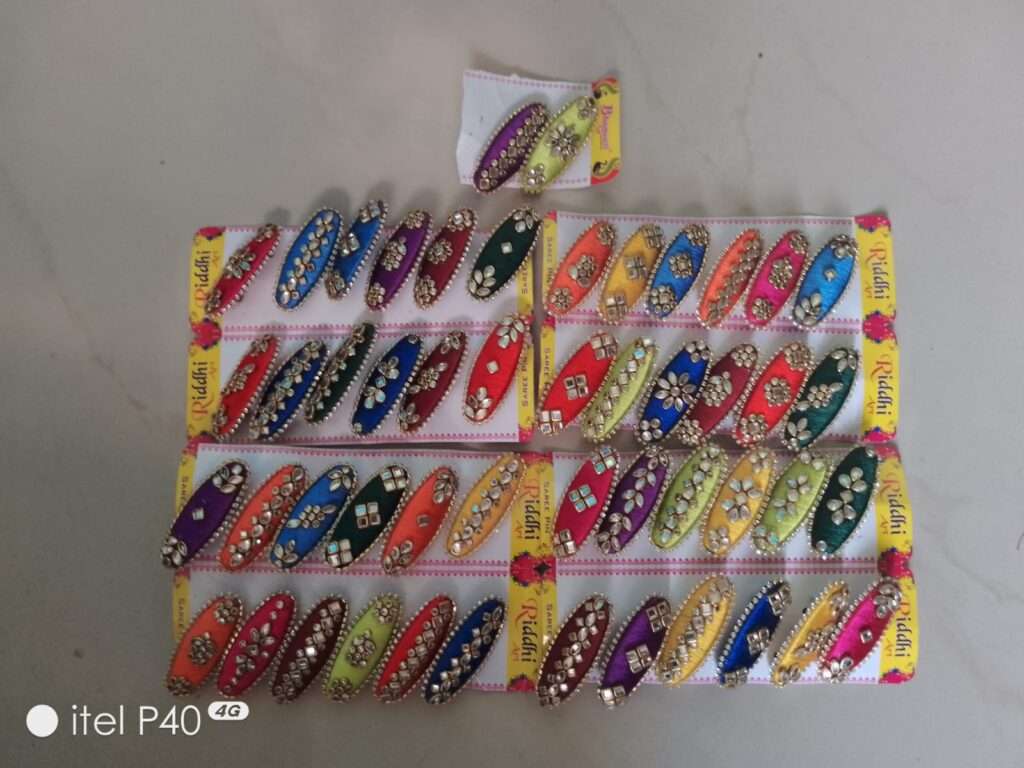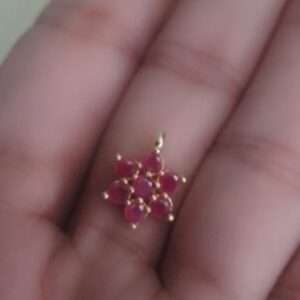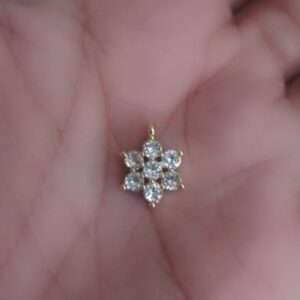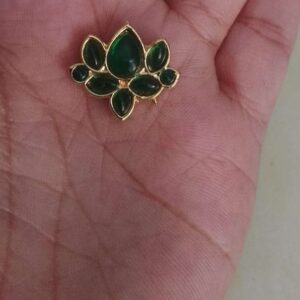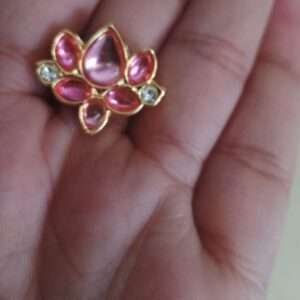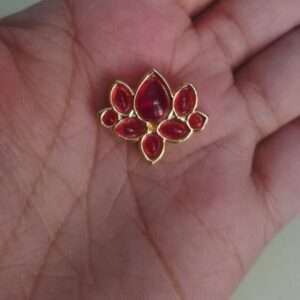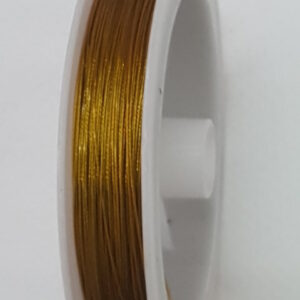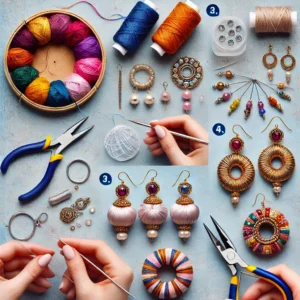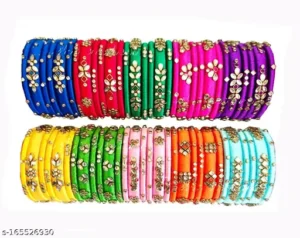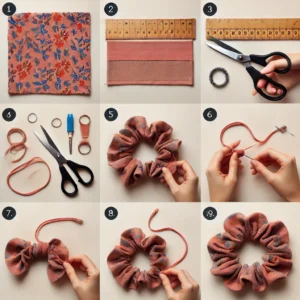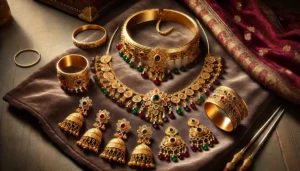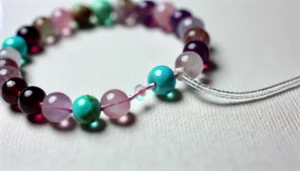Home » My blogs (Page 2)
Category Archives: My blogs
Macramé is back! Discover how ancient knotting techniques are transforming jewelry trends!
Explore the revival of macramé and knotting techniques in modern jewelry, blending ancient crafts with contemporary styles. Learn more about this trending art form.
Macramé and knotting techniques are experiencing a remarkable revival in the world of jewelry design, captivating fashion enthusiasts and artisans alike with their intricate patterns and bohemian charm. Rooted in ancient crafting traditions, these techniques involve the art of tying knots to create beautiful, textured designs that can be adapted into various jewelry pieces, from earrings and bracelets to necklaces and anklets. As fashion trends continue to embrace artisanal craftsmanship and sustainability, macramé jewelry is becoming a standout choice for those seeking unique, handmade accessories.
The Historical Significance of Macramé and Knotting in Craft
Macramé, a craft that dates back centuries, is believed to have originated with 13th-century Arab weavers who used knotting techniques to create decorative fringes on textiles. The art form spread throughout Europe, where it became popular among sailors who used it to pass the time while at sea. By the Victorian era, macramé became a fashionable home decor trend, often used to create intricate wall hangings and plant holders.
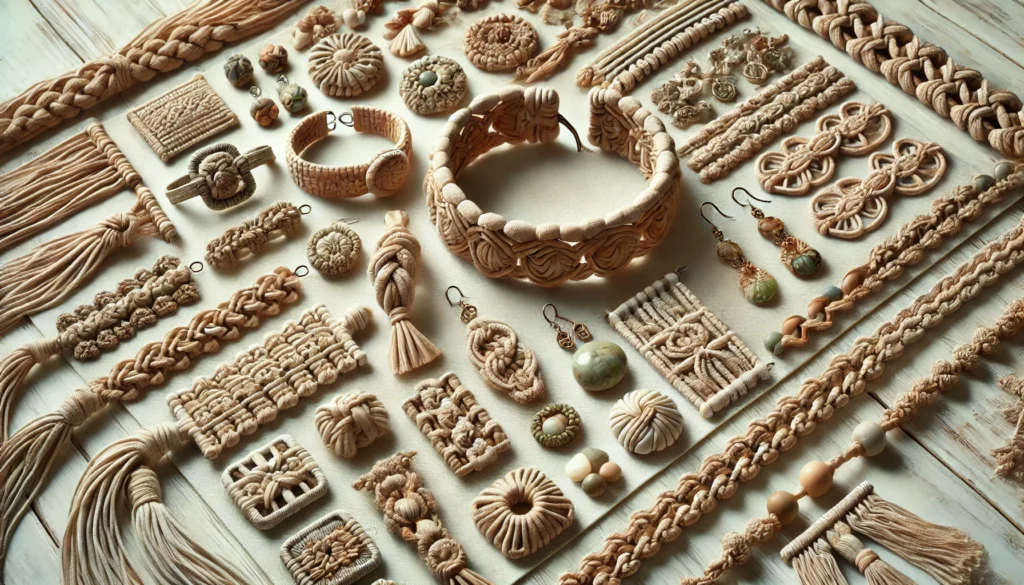
In jewelry design, macramé and other knotting techniques bring a rich history of craftsmanship to contemporary fashion. Fashion historian Mark Jensen stated that “macramé is more than just a decorative art; it’s a versatile craft that speaks to the history of human creativity.” Today, artisans are reviving these ancient techniques to create modern, stylish jewelry that appeals to a wide range of tastes.
How Macramé Jewelry is Crafted
Creating macramé jewelry involves a meticulous process that requires patience, skill, and an eye for detail. Artisans use various knotting techniques, such as the square knot, half-hitch knot, and lark’s head knot, to create intricate patterns and textures. The jewelry pieces are often made from materials like cotton, hemp, linen, or waxed cords, which provide both durability and a natural, earthy aesthetic.
Macramé jewelry can be adorned with beads, shells, or semi-precious stones to add a touch of elegance and uniqueness. The process typically begins with designing a pattern and measuring out cords of varying lengths. The artisan then carefully ties knots to create the desired design, adjusting the tension and spacing to ensure uniformity. Jewelry designer Elisa Ramos mentioned that “macramé offers a tactile experience—each knot is carefully tied, making every piece of jewelry unique and personal.”
The Growing Popularity of Macramé Jewelry in Modern Fashion
The resurgence of macramé and knotting techniques in jewelry can be attributed to several factors, including the rise of bohemian fashion, a renewed interest in handcrafted accessories, and the emphasis on sustainable, slow fashion. Unlike mass-produced jewelry, each piece of macramé jewelry is handmade, making it inherently more sustainable and environmentally friendly.
The aesthetic appeal of macramé jewelry also plays a significant role in its popularity. The textured patterns and natural materials give macramé jewelry a unique, earthy vibe that pairs well with various styles, from casual, everyday wear to more elaborate, boho-chic looks. Fashion influencer Claire Donovan noted that “macramé jewelry has a timeless appeal; it’s both rustic and refined, making it perfect for those who love to mix and match styles.”
The Future of Macramé and Knotting Techniques in Jewelry Design
Experts believe that macramé and knotting techniques will continue to thrive in the jewelry industry, especially as consumers increasingly prioritize sustainability and artisanal quality. The craft’s adaptability allows for a wide range of designs, from minimalist pieces to bold statement jewelry, ensuring its relevance in the ever-evolving fashion landscape.
Craft industry expert Julia Harmon emphasized that “macramé is more than just a trend—it’s a celebration of craftsmanship and creativity. As more people seek out unique, handmade jewelry that tells a story, macramé will continue to grow in popularity.” She added that with the rise of online platforms like Etsy and Instagram, artisans now have more opportunities to showcase their macramé jewelry to a global audience, further fueling the trend.
A Timeless Craft with Modern Appeal
Macramé and knotting techniques are proving that ancient crafts can find new life in modern jewelry design. As artisans continue to innovate and explore the possibilities of these versatile techniques, macramé jewelry will remain a popular choice for those who appreciate the beauty of handmade, sustainable accessories. With its blend of history, artistry, and contemporary style, macramé is truly a craft for the ages.
Why costume jewelry is making a huge comeback – and it’s more glamorous than ever!
Dive into the world of costume jewelry and fashion accessories, exploring their bold resurgence in affordable glamour and modern style trends.
Costume jewelry and fashion accessories are witnessing a significant resurgence, redefining the concept of affordable glamour in the fashion world. As consumers increasingly look for stylish yet economical ways to express themselves, costume jewelry is stepping into the spotlight with its bold designs, vibrant colors, and endless versatility. These non-precious pieces, often crafted from materials like glass, plastic, and brass, offer the perfect solution for those who want to stay on-trend without breaking the bank. This trend marks a shift away from traditional, high-cost jewelry, embracing a more accessible and diverse approach to fashion.
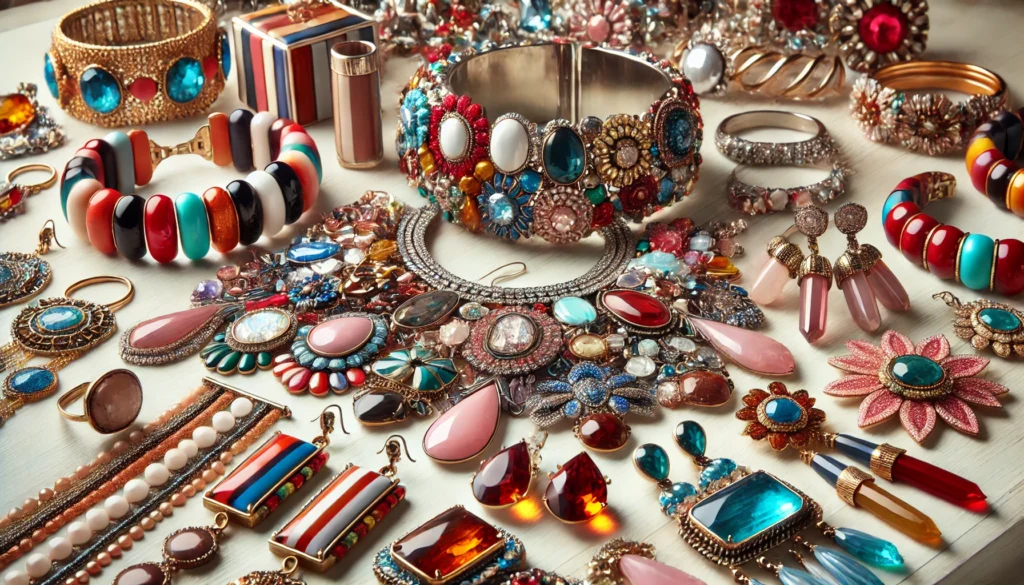
The Evolution of Costume Jewelry
Costume jewelry, also known as fashion jewelry, dates back to the early 20th century when designers like Coco Chanel popularized the concept of accessorizing with non-precious pieces. This idea allowed the masses to enjoy fashion at a fraction of the cost of fine jewelry, democratizing style. Since then, costume jewelry has evolved through various phases—from the Art Deco styles of the 1920s to the bold, colorful pieces of the 1980s, and now, to the eclectic, personalized styles seen today.
Today’s costume jewelry is about more than just affordability; it’s about self-expression and creating statement looks. Fashion historian Laura McBride explained that “costume jewelry has always been a way for people to experiment with their style without the commitment of high costs. It reflects the times, culture, and individual creativity.” As a result, these pieces have become an integral part of modern wardrobes.
How Costume Jewelry is Crafted
The creation of costume jewelry involves a combination of traditional and modern techniques. Materials such as glass, acrylic, resin, wood, and base metals are commonly used to create diverse styles that range from minimalist to flamboyant. Designers often use molding, casting, and electroplating methods to shape these materials into rings, earrings, necklaces, and bracelets that mimic the appearance of fine jewelry.
One of the defining features of costume jewelry is the use of imitation gemstones like cubic zirconia, rhinestones, or even colored glass. These substitutes provide the sparkle and allure of real gemstones without the high price tag. Jewelry designer Adam Cole remarked that “the beauty of costume jewelry lies in its ability to imitate luxury without the cost. It’s a playground for creativity where almost anything goes.”
The Rising Popularity of Costume Jewelry in Modern Fashion
The resurgence of costume jewelry is largely driven by the current fashion climate, which emphasizes versatility, sustainability, and personal style. With fast fashion’s reputation under scrutiny for its environmental impact, costume jewelry offers a more sustainable approach by allowing consumers to update their wardrobes with minimal investment. Furthermore, these pieces can easily be mixed and matched, providing endless options for outfit customization.
The rise of digital influencers and social media platforms has also played a significant role in bringing costume jewelry back into the limelight. These platforms have become powerful tools for brands and independent designers to showcase their collections and connect with a broader audience. Style influencer Nia Clarke noted that “costume jewelry allows people to experiment with trends without a long-term commitment, making it ideal for today’s fashion-forward, budget-conscious shoppers.”
The Future of Costume Jewelry and Fashion Accessories
Experts believe that costume jewelry will continue to thrive as a staple in modern fashion, particularly as consumers seek more sustainable, affordable, and versatile options. The ability to create unique looks with minimal investment is a strong appeal, especially in an era where personal style is highly valued.
Fashion market analyst Serena Patel emphasized that “costume jewelry is more than just an accessory; it’s a form of self-expression. Its adaptability makes it a permanent fixture in the fashion industry.” With advancements in materials and production techniques, the potential for innovation in costume jewelry is vast, promising a future full of bold and creative designs.
Affordable Glamour for Every Occasion
Costume jewelry and fashion accessories have cemented their place in the world of style by offering a perfect blend of affordability, versatility, and creativity. As the fashion industry continues to evolve, these pieces will remain essential for those looking to add a touch of glamour to their everyday outfits without a hefty price tag. With the rise of new trends and changing consumer preferences, the future of costume jewelry looks brighter—and bolder—than ever.
Upcycled jewelry is taking over fashion – and here’s why you need to be a part of it!
Explore the growing trend of textile crafts and upcycled jewelry that blends sustainability with creativity. Learn how these unique pieces are reshaping fashion.
Textile crafts and upcycled jewelry are making waves in the fashion world, redefining sustainability with creativity and style. In a time when environmental consciousness is paramount, more consumers and designers are turning to upcycled jewelry crafted from recycled fabrics, old clothing, and discarded materials. This trend is not only eco-friendly but also offers a fresh take on fashion accessories, where each piece carries a story and a purpose. By merging traditional textile crafts with modern upcycling techniques, designers are creating unique jewelry that appeals to those who want to make a fashion statement with minimal environmental impact.
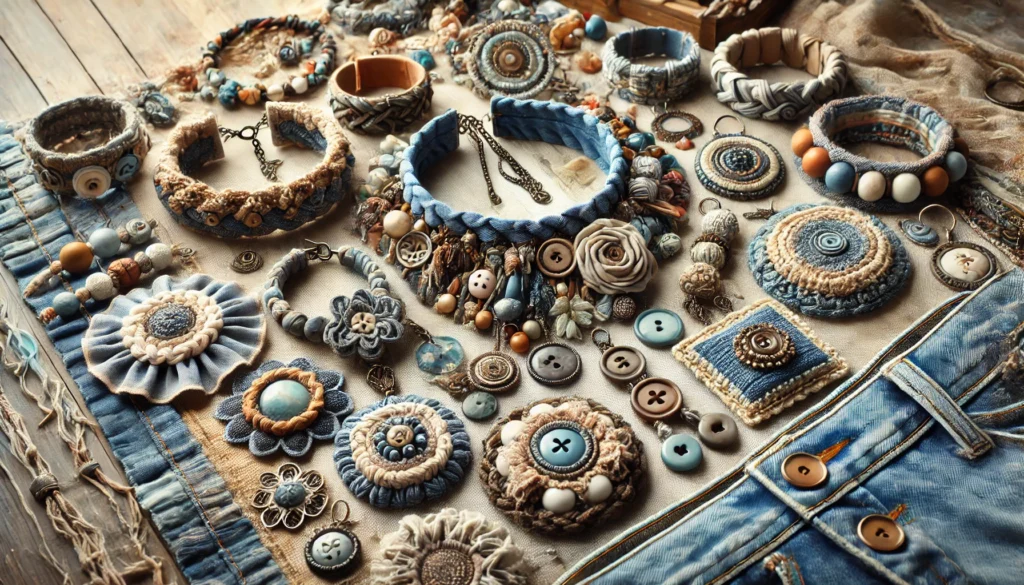
The Rise of Upcycled Jewelry in Sustainable Fashion
The concept of upcycled jewelry is gaining popularity as part of a broader movement toward sustainable fashion. Unlike traditional recycling, upcycling involves repurposing materials into new products with higher quality or artistic value. This approach allows designers to transform old fabrics, scraps, and discarded clothing into one-of-a-kind jewelry pieces that are both stylish and environmentally friendly. The use of textile crafts such as weaving, knitting, and crochet adds a rich, handmade touch to these pieces.
Fashion sustainability advocate Jenna Meyer noted that “upcycled jewelry is a revolutionary step in sustainable fashion. It’s about reimagining waste as a resource and creating something beautiful and meaningful out of it.” This philosophy resonates strongly with consumers who are becoming increasingly mindful of the environmental impact of their purchases.
How Upcycled Jewelry is Crafted
Creating upcycled jewelry from textiles and other materials involves a thoughtful and creative process. Designers begin by sourcing materials, such as fabric scraps, old denim, leather offcuts, or vintage lace, often collecting these from thrift stores, garment factories, or even their own closets. The next step involves deconstructing these materials and reimagining them into new forms. Techniques like weaving, braiding, sewing, and embroidery are commonly used to transform these discarded textiles into wearable art.
For example, an upcycled denim necklace might start with strips of old jeans braided together and adorned with beads or metal charms. A pair of earrings could be crafted from vintage lace, stiffened with eco-friendly solutions, and embellished with repurposed buttons or broken jewelry pieces. Jewelry designer Lara Thompson explained that “upcycling allows for an immense amount of creativity. Each piece is a challenge to see the potential in something discarded.”
The Growing Popularity of Upcycled Jewelry
Upcycled jewelry is gaining traction for several reasons. First, it aligns with the principles of sustainable fashion by reducing waste and minimizing the demand for new raw materials. This eco-friendly approach not only helps the environment but also encourages a shift away from the fast fashion model, which is notorious for its negative impact on the planet.
Second, upcycled jewelry offers a sense of uniqueness and exclusivity. Each piece is handmade and one-of-a-kind, providing consumers with a personal connection to their accessories. This individuality stands in stark contrast to mass-produced jewelry, where uniformity is the norm. Fashion influencer and sustainability advocate Mia Chen observed that “upcycled jewelry is for those who want to stand out and support ethical fashion. It tells a story that mass-produced items simply cannot.”
The Future of Textile Crafts and Upcycled Jewelry
Experts believe that upcycled jewelry will continue to grow in popularity as more consumers seek sustainable and ethically produced fashion. The versatility of textile crafts combined with the creativity of upcycling provides endless possibilities for innovation. Moreover, as the fashion industry grapples with the need for sustainable practices, upcycled jewelry is positioned as a forward-thinking solution.
Sustainable fashion consultant Nadia Patel stated that “upcycled jewelry is not just a trend; it’s a necessary evolution in the fashion industry. It challenges the traditional fashion cycle and introduces a new way of thinking about waste and design.” With more designers embracing upcycling and consumers supporting these initiatives, the future of textile crafts and upcycled jewelry looks promising.
Fashion with Purpose and Innovation
Textile crafts and upcycled jewelry represent a powerful fusion of sustainability and creativity, offering a fresh perspective on what fashion accessories can be. As the movement toward eco-conscious fashion grows stronger, upcycled jewelry will continue to shine as a meaningful and stylish alternative to traditional jewelry. For those looking to make a fashion statement that is both beautiful and impactful, upcycled jewelry provides the perfect opportunity.
The online boom in handmade jewelry sales – find out how e-commerce is changing the game!
Discover how online craft marketplaces and e-commerce are transforming the handmade jewelry industry, making unique designs accessible to a global audience.
Online craft marketplaces and e-commerce platforms are revolutionizing the way handmade jewelry is bought and sold, connecting artisans with a global audience like never before. Gone are the days when handmade jewelry was limited to local markets and craft fairs; today, thanks to the rise of digital platforms, artisans can showcase their unique creations to customers around the world with just a few clicks. This digital shift has not only expanded market access but also empowered independent designers to thrive in an increasingly competitive industry. As e-commerce continues to grow, it is reshaping the landscape of handmade jewelry, bringing creativity and craftsmanship to the forefront of global fashion.
The Growth of Online Craft Marketplaces
The emergence of online craft marketplaces such as Etsy, Amazon Handmade, and eBay has been a game-changer for the handmade jewelry industry. These platforms provide a dedicated space for artisans to list their products, reach a wider audience, and build their brands. Unlike traditional retail, which often requires significant overhead and inventory management, online marketplaces offer a more accessible entry point for independent designers. This democratization of retail has led to an explosion of creativity, with countless unique jewelry pieces now available to consumers worldwide.
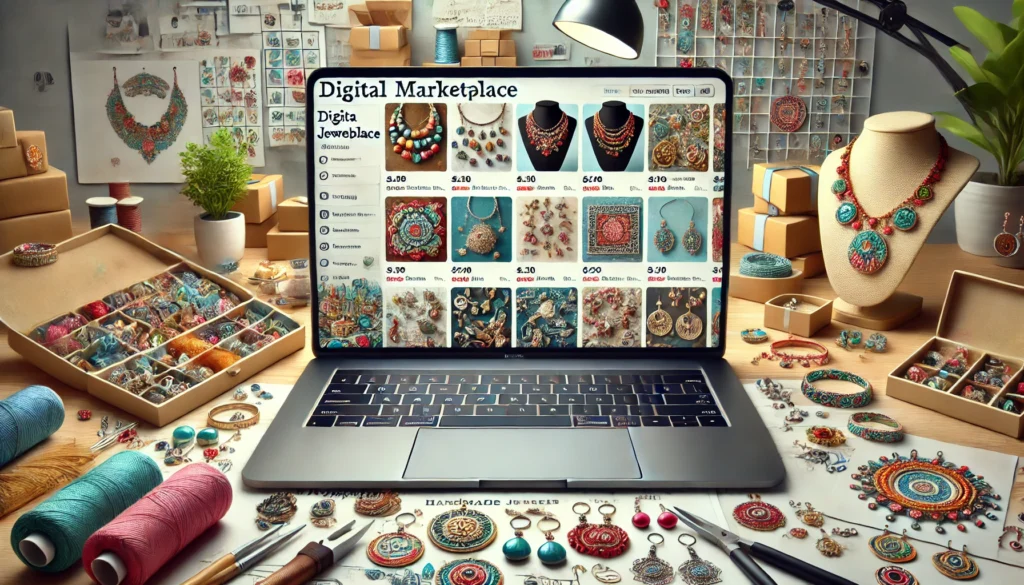
Artisan jewelry maker Sarah Bennett remarked that “online marketplaces have given small designers like me the opportunity to compete with big brands. It’s not just about selling jewelry; it’s about telling my story and connecting with customers who appreciate the artistry.” This direct connection between artisans and customers is one of the key strengths of online craft marketplaces.
The Role of E-Commerce in Expanding Market Reach
E-commerce has further amplified the reach of handmade jewelry by breaking down geographical barriers and making it easier for customers to discover and purchase products from around the globe. With the click of a button, shoppers can browse a vast array of handmade jewelry, read reviews, and make informed purchasing decisions—all from the comfort of their homes. This convenience has fueled the growth of e-commerce in the handmade sector, particularly during the COVID-19 pandemic when physical shopping was restricted.
Additionally, the integration of social media with e-commerce has opened new avenues for marketing and sales. Platforms like Instagram and Pinterest have become powerful tools for showcasing jewelry, with influencers and artisans alike using these platforms to drive traffic to their online stores. Jewelry marketing expert Emily Rogers noted that “social media has transformed the way jewelry is marketed. It’s about creating a visual story that resonates with people, leading them to explore and purchase directly from online stores.”
Challenges and Opportunities in the Digital Marketplace
While the rise of online craft marketplaces and e-commerce has created significant opportunities for handmade jewelry artisans, it also comes with challenges. The increased competition in the digital space means that standing out requires more than just great products; it demands effective branding, SEO optimization, and customer engagement. Artisans must navigate the complexities of digital marketing, from search engine algorithms to social media strategies, to ensure their products are visible and appealing to potential customers.
However, the opportunities far outweigh the challenges. E-commerce allows for a level of flexibility and scalability that traditional retail cannot match. Artisans can experiment with different product lines, test new designs, and gather immediate feedback from customers. This agility is particularly valuable in the fast-paced world of fashion, where trends can change quickly. Market analyst Jessica Stone commented that “the digital marketplace is a dynamic environment that rewards innovation. Artisans who can adapt and leverage the tools available will find success in this space.”
The Future of Handmade Jewelry in E-Commerce
Experts predict that the e-commerce market for handmade jewelry will continue to grow as more consumers seek out unique, artisanal products. The convenience of online shopping, combined with the desire for personalized and meaningful jewelry, will drive this trend forward. Additionally, advancements in technology, such as augmented reality and AI-driven recommendations, are expected to enhance the online shopping experience, making it even easier for customers to find and purchase handmade jewelry.
E-commerce strategist Laura Davis emphasized that “the future of handmade jewelry is online. As technology continues to evolve, we’ll see even more innovative ways for artisans to connect with customers and showcase their work.” She added that the key to success in this space will be a combination of creativity, adaptability, and a strong online presence.
A New Era for Handmade Jewelry Sales
The rise of online craft marketplaces and e-commerce has ushered in a new era for the handmade jewelry industry, offering artisans unprecedented opportunities to reach a global audience. As the digital marketplace continues to evolve, those who embrace the power of e-commerce will thrive, bringing their unique creations to customers worldwide. With the right strategies and tools, the future of handmade jewelry sales looks brighter—and more accessible—than ever.
How jewelry design workshops are creating the next wave of creative artisans!
Explore how jewelry design courses and workshops are transforming aspiring artisans into skilled creators, fueling the handmade jewelry movement.
Jewelry design courses and workshops are becoming increasingly popular as more individuals seek to explore their creativity and break into the world of handcrafted accessories. These programs provide invaluable opportunities for aspiring artisans to learn essential skills, from the basics of wire wrapping to advanced techniques in metalwork, stone setting, and beading. As the demand for unique, handmade jewelry continues to rise, these educational platforms are playing a crucial role in shaping the next generation of talented jewelry designers. Offering both online and in-person formats, jewelry design courses and workshops are democratizing the craft, making it accessible to a diverse range of people who wish to express themselves through art.
The Growing Interest in Jewelry Design Education
The interest in jewelry design education has grown significantly in recent years, driven by the DIY movement, a renewed appreciation for handmade goods, and the rise of platforms that enable individuals to turn their craft into a viable business. Whether it’s a weekend workshop at a local studio or a comprehensive online course, these programs cater to various skill levels and provide hands-on training that empowers students to bring their creative visions to life.
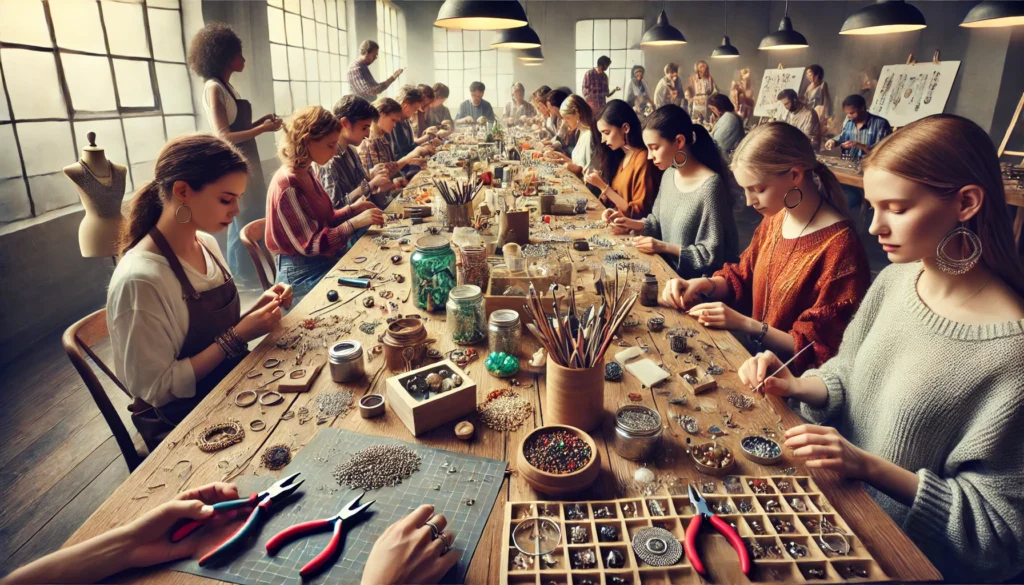
Jewelry educator and course instructor Laura Kim noted that “people are looking for more than just a hobby; they want to create something meaningful and potentially turn it into a career. Jewelry design courses offer a pathway to achieve that.” The hands-on approach of these workshops, combined with expert guidance, allows participants to gain a deep understanding of materials, tools, and techniques.
What Jewelry Design Courses Offer
Jewelry design courses and workshops typically cover a wide range of topics, from the foundational principles of design to specialized techniques like soldering, engraving, enameling, and metal forging. Beginners are introduced to essential skills such as bead stringing, wire wrapping, and basic metalwork, while more advanced students can learn stone setting, wax carving, and advanced metal manipulation.
In addition to technical skills, many courses also focus on design theory, color combinations, and trend analysis to help students develop a unique style and identity. This holistic approach ensures that graduates are not only skilled in craftsmanship but also prepared to enter the competitive market of handmade jewelry. Course facilitator and jewelry designer Aisha Patel shared that “our goal is to provide a well-rounded education that covers both creativity and business, so students are equipped to succeed in all aspects of jewelry making.”
The Impact of Workshops on the Handmade Jewelry Industry
Jewelry design workshops are not only educational but also serve as a hub for community building and collaboration. They bring together individuals with a shared passion for creativity, fostering a sense of camaraderie and support. These workshops often lead to the formation of artisan collectives, pop-up shops, and online collaborations, further enriching the handmade jewelry industry.
Moreover, by providing a space for continuous learning and experimentation, workshops encourage innovation in jewelry design. Many successful jewelry brands started as workshop projects, where designers honed their skills and developed their unique styles. Industry expert Natalie Watts pointed out that “workshops are incubators for new talent. They nurture creativity and provide the foundation for future success in the jewelry industry.”
The Future of Jewelry Design Education
Experts believe that the future of jewelry design education will be shaped by the integration of digital tools and online platforms. While in-person workshops provide the benefit of hands-on experience, online courses offer flexibility and accessibility to a global audience. Hybrid models that combine both formats are likely to become the norm, providing a comprehensive learning experience.
Jewelry education consultant Robert Greene emphasized that “the future of jewelry design education lies in adaptability. Blending traditional techniques with modern technology, such as 3D printing and digital design software, will prepare the next generation of jewelry designers for a rapidly evolving market.” He added that the ongoing growth of the handmade jewelry sector will continue to drive demand for quality education and skill development.
Crafting the Future of Jewelry Design
Jewelry design courses and workshops are vital in empowering aspiring artisans and fostering creativity in the handmade jewelry industry. By offering a blend of traditional craftsmanship and modern innovation, these educational programs are creating a new wave of talented jewelry designers who are ready to shape the future of fashion accessories. For those looking to turn their passion for jewelry making into a career or simply explore a new hobby, these courses provide the perfect starting point.
Why Silk Thread Jewellery is the Next Big Thing in Sustainable Fashion
Silk thread materials have long been a cornerstone in the jewellery-making traditions of India. Their unique qualities—elegance, flexibility, and cultural significance—make them indispensable in the creation of intricate and beautiful adornments. As the world shifts towards more sustainable and eco-friendly practices, the relevance of silk thread in jewellery has only grown. This article delves into the multifaceted aspects of silk thread jewellery, exploring its traditional uses, manufacturing processes, popular designs, and more.
Interested in custom silk thread jewellery? Hi, I’m Pallavi. I specialize in creating unique, handcrafted silk thread jewellery tailored to your preferences. Whether you’re looking for traditional designs or something modern, I can craft it just for you. Contact me on WhatsApp to place your order today!
Traditional uses of silk thread in jewellery making
Silk thread has been a pivotal element in Indian jewellery for centuries. Its use extends beyond mere aesthetics; it carries with it deep cultural and spiritual meanings. In religious ceremonies, silk thread jewellery is often worn as a symbol of purity and prosperity. Festivals such as Diwali, Navratri, and weddings are incomplete without the adornment of women in silk thread bangles, necklaces, and earrings. The thread’s softness and ability to hold vibrant dyes make it perfect for creating pieces that stand out, whether it’s a simple bangle or an elaborate necklace.
The cultural importance of silk thread in jewellery also reflects in its association with specific rituals and customs. For instance, in South India, brides often wear silk thread jewellery as part of their wedding attire, symbolizing purity and the weaving of new bonds. The intricate patterns and bright colours that silk thread jewellery offers are not just about decoration; they are a statement of tradition, heritage, and continuity.
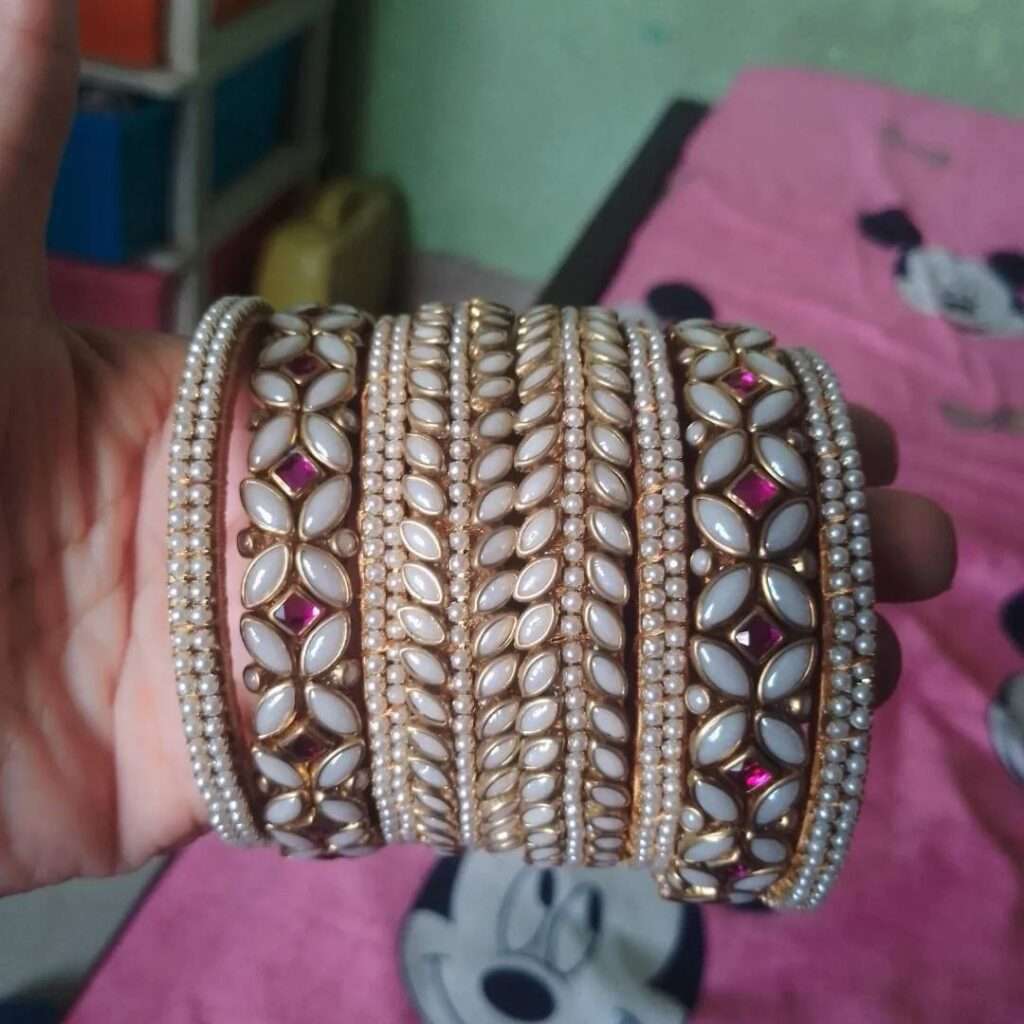
How silk thread is manufactured for use in jewellery
The journey of silk thread from raw material to a finished product suitable for jewellery is a meticulous process. It all starts with the cultivation of mulberry plants, the primary food source for silkworms. The silkworms, in turn, produce silk, which is harvested by carefully unwinding the silk cocoons.
Once the silk is collected, it undergoes a series of processes to transform it into thread. Dyeing is one of the first steps, where the raw silk is immersed in vibrant colours. The choice of dyes and the technique used can greatly influence the final appearance of the jewellery. Spinning follows, where the dyed silk is spun into fine threads, ensuring that they are strong yet flexible. The final step, weaving, involves combining these threads into various forms, depending on the intended use—whether for earrings, bangles, or necklaces.
The quality of the silk thread is paramount, as it determines the durability and appearance of the jewellery. Artisans pay close attention to every detail, ensuring that the thread is not only strong enough to withstand the rigors of wear but also delicate enough to create intricate designs.
Popular designs of silk thread jewellery in India
India’s diverse cultural landscape is reflected in its jewellery designs, and silk thread is no exception. Some of the most popular silk thread jewellery designs include Kundan, Meenakari, and Jhumkas.
- Kundan Jewellery: This design involves setting precious stones in a gold foil base, and silk thread is often used to add a colourful and textured backdrop. The result is a piece of jewellery that is both luxurious and vibrant.
- Meenakari Work: Known for its enamel designs, Meenakari jewellery often incorporates silk thread to enhance the vividness of the colours and add depth to the overall design.
- Jhumkas: These traditional Indian earrings are often made using silk thread, which allows for a wide range of colours and patterns. The thread is wound tightly around the earring base, creating a rich texture that is both lightweight and eye-catching.
These designs are not just popular in India but have also gained international recognition, with silk thread jewellery being exported to various countries. The versatility of silk thread allows designers to experiment with different styles, making it a popular choice for both traditional and contemporary jewellery.
Comparing the durability of silk thread to other jewellery materials
When it comes to durability, silk thread is often compared to other materials like metals and synthetic threads. While it may not be as robust as metals, silk thread offers a unique combination of softness and flexibility that other materials cannot match.
- Durability: Silk thread is less durable than metals like gold or silver. However, its natural elasticity and ability to absorb dyes make it a preferred choice for designs that require intricate weaving and vibrant colours.
- Comparison with Synthetic Threads: Unlike synthetic threads, silk is a natural fibre, which makes it biodegradable and eco-friendly. However, synthetic threads might offer more strength and durability but lack the natural sheen and feel of silk.
- Longevity: With proper care, silk thread jewellery can last for years. It’s important to follow best practices in maintenance to ensure the longevity of the jewellery.
Silk thread’s durability may be seen as a limitation, but for those who value elegance and craftsmanship, it is a small trade-off. The unique qualities of silk thread, such as its softness and ability to hold vibrant colours, make it a valuable material in the world of jewellery.
Best practices for maintaining and storing silk thread jewellery
Maintaining silk thread jewellery requires special care due to its delicate nature. Proper cleaning and storage are essential to preserving the quality and appearance of the pieces.
- Cleaning: Silk thread jewellery should be cleaned gently using mild soap and lukewarm water. Harsh chemicals or abrasive materials should be avoided as they can weaken the thread and cause the colours to fade.
- Storage: Proper storage is crucial for maintaining the condition of silk thread jewellery. It should be kept in airtight containers to prevent exposure to moisture, which can lead to mould or mildew. Additionally, storing silk thread jewellery away from direct sunlight will help preserve the vibrancy of the colours.
- Handling: When wearing or handling silk thread jewellery, it’s important to avoid excessive pulling or tugging, as the thread can be delicate. It’s also advisable to remove the jewellery before engaging in activities that might expose it to water or chemicals.
By following these best practices, the beauty and durability of silk thread jewellery can be maintained for years, allowing it to be passed down as a treasured heirloom.
Evolution of demand for silk thread jewellery over the past decade
The demand for silk thread jewellery has evolved significantly over the past decade. A key driver of this growth has been the increasing consumer preference for eco-friendly and sustainable fashion. As awareness about environmental issues has risen, more people are turning towards natural materials like silk thread as opposed to synthetic alternatives.
- Market Trends: The market for silk thread jewellery has expanded both domestically and internationally. In India, traditional silk thread jewellery has seen a resurgence, particularly during festivals and weddings. Internationally, there has been a growing interest in handmade and artisanal products, with silk thread jewellery being a popular choice.
- Social Media Influence: The rise of social media platforms has also played a role in popularizing silk thread jewellery. Influencers and fashion bloggers often showcase these pieces, highlighting their beauty and cultural significance, which in turn drives demand.
- Export Markets: Silk thread jewellery has become a popular export product, with countries like the United States, the United Kingdom, and Australia showing significant demand. The global appeal of silk thread jewellery lies in its uniqueness and the fact that each piece often carries a story of tradition and craftsmanship.
The growing demand for silk thread jewellery reflects a broader shift towards more conscious consumerism, where the focus is not just on aesthetics but also on the sustainability and ethics of fashion choices.
Environmental impacts of producing silk thread for jewellery
While silk thread is a natural and biodegradable material, its production does have environmental implications. The cultivation of mulberry plants and the rearing of silkworms require significant resources, including water, land, and energy.
- Resource Consumption: Mulberry cultivation, which is necessary for silkworm rearing, demands large amounts of water and land. This can lead to issues such as water scarcity and deforestation in regions where mulberry farming is intensive.
- Pollution: The dyeing process, which is essential for giving silk thread its vibrant colours, can contribute to water pollution if not managed properly. The use of natural dyes is one way to mitigate this impact, but it is not yet widespread.
- Sustainability: Despite these challenges, silk is a renewable resource, and with sustainable farming practices, the environmental impact of silk production can be minimized. Biodegradability
The Fascinating World of Half-Cut Pearls
Pearls have long been associated with luxury, class, and timeless elegance. For decades, they have been a popular choice for jewelry pieces such as necklaces, earrings, and bracelets. While full pearls have always been a traditional favorite, it’s the half-cut pearls that have recently been gaining traction in the jewelry industry. The allure of half-cut pearls lies in their unique form, which opens up new avenues for design possibilities and creative expression.
Checkout available half cut pearls and beads in the shop section.
A half-cut pearl is exactly what its name suggests: a pearl that has been carefully cut in half. This process exposes the pearl’s inner layers, offering a different visual aesthetic compared to a full, rounded pearl. When it comes to half-cut pearls, the design possibilities are endless. They can be set flat against rings, embedded into bracelets, or even used as unique focal points in necklaces. The feature that sets them apart is the sheer brilliance that the exposed layer adds to the overall design.
What makes half-cut pearls particularly appealing is their unconventional beauty. Unlike their fully-rounded counterparts, half-cut pearls offer a certain depth and texture that make each piece look intricate and unique. When light interacts with the layers of a half-cut pearl, the resulting luminosity is unparalleled. Jewelers often experiment with these pearls to create stunning, eye-catching designs that are both contemporary and timeless. The fashion-forward yet classic vibe of half-cut pearls has made them the go-to choice for modern women who crave a touch of tradition in their jewelry.
When it comes to the quality and craftsmanship of half-cut pearls, meticulous attention to detail is crucial. Cutting a pearl in half is a delicate operation that requires skill, patience, and precision. The aim is to retain the pearl’s lustrous qualities while exposing its inner beauty. Therefore, it’s imperative to choose your half-cut pearls from a reputable jeweler who specializes in pearl jewelry. Often, the finest half-cut pearls are sourced from freshwater or saltwater oysters, ensuring that each piece is of the highest quality.
Despite their modern appeal, the history of half-cut pearls traces back to ancient civilizations, where they were often used as decorative inlays in furniture, boxes, and even architectural elements. Their resurgence in modern-day jewelry is a nod to their historical significance and timeless allure. Whether you opt for a minimalist design or something elaborate, incorporating half-cut pearls into your jewelry collection will undoubtedly elevate your style.
In summary, half-cut pearls are captivating the jewelry world with their unique charm and endless design possibilities. From their intricate beauty to their unparalleled luminosity, half-cut pearls offer something extraordinary that traditional full pearls simply cannot. Whether you’re a jewelry aficionado or new to the pearl scene, half-cut pearls are a versatile and sophisticated choice that can adapt to various styles and occasions. Choosing to invest in a piece featuring half-cut pearls is not just a fashion statement; it’s a nod to a unique blend of modern creativity and timeless elegance.
Making Silk Thread Saree Pins: A Step-by-Step Guide
Silk thread saree pins are a popular accessory that adds a touch of elegance to traditional Indian attire. If you’re interested in making your own silk thread saree pins, here’s a step-by-step guide to help you get started:
Materials Needed:
- Silk threads in desired colors
- Saree pin blanks or safety pins
- Craft glue
- Scissors
- Beads, pearls, or embellishments (optional)
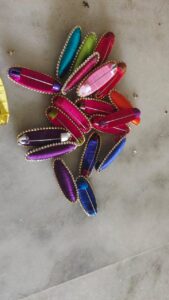
Step 1: Prepare the Saree Pin Blank If you’re using saree pin blanks, ensure they are clean and free of any dust or residue. If you don’t have saree pin blanks, you can use regular safety pins. Start by opening the pin and removing any attached components like chains or charms.
Step 2: Wrapping the Silk Thread Choose the color of silk thread you want for your saree pin. Apply a small amount of craft glue at the top of the pin or blank. Secure the starting end of the silk thread on the glued area and hold it in place until it sets.
Wrap the silk thread tightly around the pin or blank, covering the entire surface. Continue wrapping until you reach the bottom. Apply glue intermittently to secure the thread. Cut off any excess thread and glue the end to secure it.
Step 3: Adding Embellishments (Optional) To enhance the beauty of your saree pin, you can add beads, pearls, or other embellishments. Use craft glue to attach them to the wrapped silk thread. You can create patterns or designs using different colors and sizes of beads or pearls.
Step 4: Finishing Touches Inspect your silk thread saree pin for any loose ends or imperfections. Trim any excess thread and make sure all the embellishments are securely attached. Allow the glue to dry completely before using your saree pin.
You can make multiple silk thread saree pins using different colors and designs to match various sarees or outfits. These pins can also be great handmade gifts for family and friends. Experiment with different thread colors, bead combinations, and styles to create unique and personalized saree pins.
Remember to be patient and take your time while wrapping the silk thread to ensure a neat and tidy finish. With practice, you’ll be able to create beautiful and stylish silk thread saree pins that complement your traditional attire. Enjoy the process of crafting and showcasing your creativity through these lovely accessories!
Making Silk Thread Jhumkas: A Step-by-Step Guide
Silk thread jhumkas are beautiful and vibrant earrings that can add a touch of elegance to any outfit. If you’re interested in making your own silk thread jhumkas, here’s a step-by-step guide to help you get started:
Materials Needed:
- Silk threads in desired colors
- Jhumka bases or pre-made jhumka caps
- Earring hooks
- Craft glue
- Scissors
- Beads, pearls, or embellishments (optional)
- Jump rings (optional)
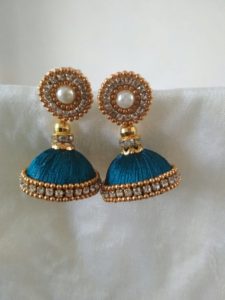
Step 1: Prepare the Jhumka Base If you’re using jhumka bases, ensure they are clean and free of any dust or residue. If you don’t have jhumka bases, you can create a base using thick cardboard or any other sturdy material. Cut out a circular shape for the base and make a small hole at the top for the earring hook.
Step 2: Wrapping the Silk Thread Choose the color of silk thread you want for your jhumka. Start by applying a small amount of craft glue at the top of the jhumka base or cardboard. Secure the starting end of the silk thread on the glued area and hold it in place until it sets.
Wrap the silk thread tightly around the base, making sure there are no gaps. Continue wrapping until the entire base is covered. Apply glue intermittently to secure the thread. Cut off any excess thread and glue the end to secure it.
Step 3: Creating the Jhumka Shape To create the traditional jhumka shape, take a long piece of silk thread and tie it tightly around the bottom edge of the wrapped base. Make a loop with the thread, ensuring it is large enough to give the jhumka its characteristic bell shape. Secure the loop by wrapping the thread tightly around it a few times and knotting it securely.
Step 4: Adding Embellishments (Optional) If you want to add beads, pearls, or other embellishments to your jhumkas, this is the time to do so. Use craft glue to attach them to the wrapped silk thread. You can get creative and experiment with different designs and patterns.
Step 5: Attaching the Earring Hook Insert the earring hook through the hole at the top of the jhumka base. Ensure it is securely in place. If needed, you can use jump rings to connect the hook and the jhumka for added stability.
Step 6: Finishing Touches Inspect your silk thread jhumkas for any loose ends or imperfections. Trim any excess thread and make sure all the embellishments are securely attached. Allow the glue to dry completely before wearing or gifting your jhumkas.
With these simple steps, you can create your own beautiful silk thread jhumkas. Feel free to experiment with different colors, designs, and embellishments to customize your jhumkas according to your style and preference. Enjoy the process and embrace your creativity while making these stunning earrings!
Checking Bangle Size: A Guide to Finding the Right Fit
When it comes to bangles, finding the right size is crucial for both comfort and style. Whether you’re shopping for yourself or someone else, knowing how to check bangle size is essential. Here are a few methods you can use to determine the correct bangle size:
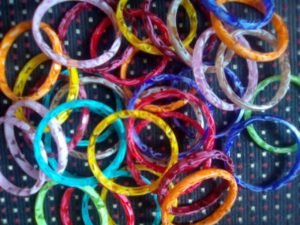
- Circumference Measurement:
- Using a flexible measuring tape or a string, measure the circumference of the widest part of your hand where the bangle needs to pass through.
- Make sure your hand is relaxed and not clenched tightly.
- Note down the measurement in inches or centimeters.
- Diameter Measurement:
- If you already have a bangle that fits well, measure its diameter.
- Lay the bangle on a flat surface and measure the straight line distance across the widest part of the inner circle.
- Record the measurement in inches or centimeters.
- Sizing Chart:
- Many jewelry retailers provide bangle sizing charts that correlate measurements with corresponding sizes.
- Compare your recorded measurements to the sizing chart to find the appropriate size.
- Keep in mind that sizing may vary slightly between different brands or regions, so double-check for accuracy.
- Test Bangle:
- If you have access to a variety of bangles, try them on to find the best fit.
- Start with a slightly larger size and gradually try smaller ones until you find the most comfortable fit.
- Pay attention to how the bangle slides over your hand and rests on your wrist.
Remember, the fit of a bangle can vary based on personal preference. Some prefer a looser fit that slides freely, while others prefer a snug fit. Additionally, consider the style of the bangle and whether you intend to wear multiple bangles together, as this may affect the desired size.
By using these methods, you can confidently check bangle sizes and ensure a comfortable and stylish fit. Whether you’re shopping online or in-store, knowing the right size will help you find the perfect bangle for yourself or as a thoughtful gift for someone else.
